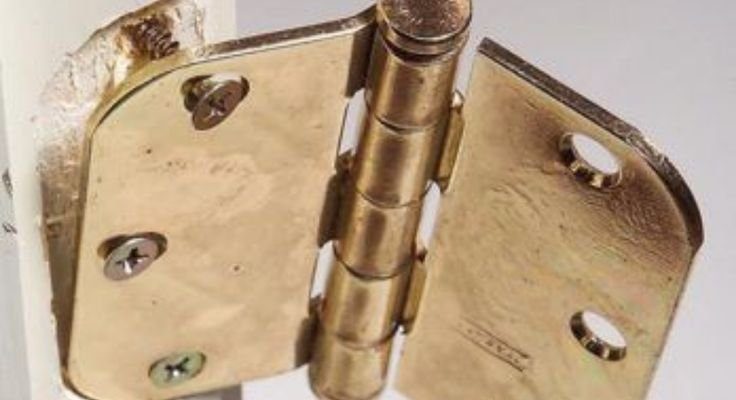
Honestly, you don’t have to be a master handyman to fix it, but you do need to know a few tricks. Whether your lock is a Kwikset, Schlage, Yale, or another common brand, stripped holes can happen to anyone. The good news? Repairing a stripped screw hole on a deadbolt faceplate is a totally doable DIY job. I’ll walk you through everything you need to know, step by step—no confusing jargon, and no intimidating tools.
Why Do Deadbolt Faceplate Screw Holes Get Stripped?
You might be wondering why these screw holes give out in the first place. It usually comes down to wear and tear. Every time you tighten or loosen those tiny screws—maybe while changing the battery, resetting the lock code, or troubleshooting a sticky latch—you put pressure on the surrounding wood or metal. Over time, especially with wood, the threads get chewed up.
In some cases, the screw is overtightened or forced in at an angle, which basically bulldozes the original threads. That makes the hole too big or too smooth for the screw to grab onto. Picture twisting a screw into a block of cheese a few times—eventually, it just spins without doing anything useful.
Of course, if the lockset wasn’t installed right in the first place, you’re more likely to run into trouble sooner. Sometimes, faceplates come loose after a heavy door slam, humidity changes, or even after resetting or syncing a smart lock’s remote control and fiddling with the unit. It’s not always your fault—it’s just life with hardware.
How to Spot a Stripped Screw Hole on Your Deadbolt Faceplate
Here’s the thing: sometimes it’s obvious, and other times, you’re left scratching your head. The most telltale sign is when you try to tighten the faceplate screw, and it just spins endlessly—no resistance, no tightening, just a sad, loose plate.
But there are other clues, too. If your faceplate wiggles or the screws fall out when you open the door, that’s a big red flag. Sometimes, you’ll notice the lock itself seems misaligned, making it tough to pair the bolt with the strike plate or even to sync the movement if you’re using a smart deadbolt.
A stripped hole can start as a subtle wobble, but it gets worse fast. Even if you reset the lock or adjust the remote, that stripped hole won’t magically fix itself. Catching it early saves time and headaches.
Tools and Materials: What You’ll Need Before You Start
Let me explain—repairing a stripped screw hole on a deadbolt faceplate doesn’t require a huge toolkit. Most fixes use basic supplies you’ll find at a hardware store or maybe even in your junk drawer.
- Wood glue or toothpicks (for small repairs in wood frames)
- Wood filler or epoxy putty (for holes that are really worn out)
- Drill and drill bits (only if you’re re-drilling for a bigger screw or anchor)
- Replacement screws (sometimes a slightly longer or thicker screw does the job)
- Screwdriver (manual or electric, but keep it gentle to avoid overtightening again)
- Matchsticks or wooden dowels (for classic, time-tested hole packing)
- Sandpaper (to smooth out any rough fixes before reinstalling the faceplate)
Honestly, you don’t have to buy everything on this list—just pick the materials that match your situation. For most Schlage or Kwikset deadbolts, the screw holes are in wood, so the toothpick trick or a dab of wood glue usually works wonders.
Step-by-Step: How to Repair a Stripped Screw Hole on a Deadbolt Faceplate
Let’s break it down in simple steps. Don’t rush this part—the key is patience, not muscle.
- Remove the Faceplate: Unscrew the faceplate and set it (plus the screws) aside. If the screw won’t come out, gently pry it with a flathead screwdriver.
- Assess the Damage: Look inside the hole. If it’s just a little loose, you might get away with the toothpick fix. If it looks chewed up or huge, you’ll need filler or a dowel.
- Pack the Hole: For a quick fix, coat a few toothpicks or matchsticks with wood glue, stuff them in, and snap off the excess. Let the glue dry for at least an hour (overnight is best). If the hole is larger, use a wooden dowel coated in glue or fill it with wood filler/epoxy putty and wait for it to cure fully.
- Drill a Pilot Hole (If Needed): After the repair dries, use a small drill bit to make a tiny pilot hole. This helps the screw bite better and avoids splitting your repair.
- Reattach the Faceplate: Screw the plate back in gently. Don’t overtighten—it just undoes all your hard work.
You might be surprised how well these simple fixes hold up, even on smart locks with remotes or tricky code panels. If the screw grabs and tightens, you’re good to go.
Alternative Fixes for Metal Doors or Larger Damage
Not every deadbolt is in a wooden frame—some are in metal doors, especially on apartments or newer builds. Here, stuffing toothpicks in won’t work.
For metal, consider these options:
- Thread repair kits: These let you re-thread the stripped hole using a tap (a special tool that cuts threads) and a matching screw.
- Epoxy putty: Fill the hole, let it cure, then re-drill a pilot hole. Works for small to medium damage.
- Oversized or self-tapping screws: Sometimes a slightly bigger screw will reach new material and hold tight.
- Rivet nuts or screw anchors: If the hole is totally trashed, these provide a new threaded insert for the screw.
Just remember, when dealing with metal, avoid shortcuts—a quick fix that fails can leave your lock insecure. If your deadbolt has a remote or smart features, double-check all sync and reset codes after you reinstall everything, just to make sure nothing got knocked loose.
Preventing Stripped Screw Holes in the Future
Once you’ve fixed the stripped hole, you want to avoid doing this whole song and dance again. The best way is to avoid overtightening—it’s tempting to crank those screws down, but a gentle, snug fit is better.
Here are a few tips to keep things secure:
- Use the right screwdriver size and type: Phillips heads and flatheads need proper fit to avoid slipping and stripping.
- Don’t overtighten: Stop turning as soon as you feel real resistance, especially on soft wood or older doors.
- Check alignment regularly: Make sure your deadbolt and strike plate are properly paired so the faceplate isn’t taking extra stress.
- Keep an eye on humidity: Wood swells and shrinks with the seasons, which can loosen hardware. A quick retighten (without force) every few months helps.
If you’re working on a smart deadbolt, remember that frequent battery changes, programming resets, or code pairing can put extra wear on the screws. Just slow down and use care each time.
When to Call a Pro (And Why It’s Sometimes Worth It)
Let’s be honest: most of the time, fixing a stripped screw hole on a deadbolt faceplate is a quick DIY win. But there are situations where it’s smarter to call a locksmith or contractor.
If your repair attempts fail—meaning the screw still won’t hold, or the faceplate is falling off again quickly—there may be hidden damage in the door, or maybe the lockset itself is failing. This is especially true with older doors, metal frames, or high-tech locks with complex wiring and remotes that need careful handling.
I get it—nobody wants to spend money on a pro for what feels like a tiny problem. But when it comes to your front door’s main security, cutting corners isn’t worth it. A locksmith can properly troubleshoot, reset, or even upgrade your deadbolt to something more secure.
A little upfront investment can save big headaches (and maybe even an emergency lockout) down the line.
Comparing DIY Solutions for Different Deadbolt Brands
You might wonder if certain deadbolts—like Schlage, Kwikset, or Yale—need special treatment. The core repair steps are almost always the same, since most faceplates use similar mounting systems. What changes is sometimes the size and type of screws or the material of the door.
For example:
- Schlage and Yale often use longer screws that reach into the door frame for extra strength. If you’re using the toothpick trick, make sure your packing goes deep enough.
- Kwikset screws are usually a standard size but sometimes use security bolts, which makes replacing them a bit trickier.
- For smart locks with battery compartments and remotes, be extra gentle with wiring and code resets during reinstallation—don’t pinch cables or forget to sync the lock afterward.
If your lock brand uses unique mounting plates or hidden screws (sometimes under battery covers), take a photo before you take it apart. That way, you always have a guide to pair everything back together.
Bringing It All Together: Secure, Simple, and Long-Lasting Repairs
Fixing a stripped screw hole on a deadbolt faceplate isn’t glamorous, but it’s one of those small DIY projects that makes your home safer and your life a bit easier. Whether you’re using toothpicks and glue or going with a heavy-duty filler, the key is a secure, snug fit that won’t wiggle loose next time you change a battery or punch in a new code.
If you run into trouble, don’t hesitate to look up your deadbolt’s brand for specific tips—or call a pro if something feels off. With a little care and patience, your lock will feel solid again, and you’ll know exactly what to do next time a tiny screw tries to ruin your day.
